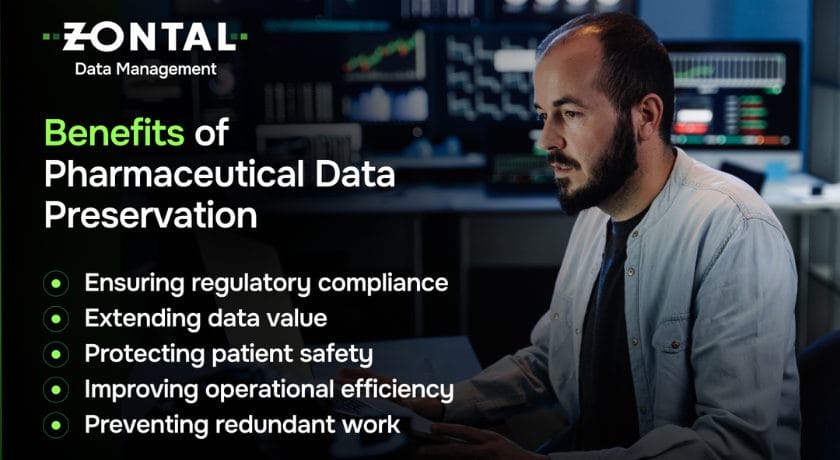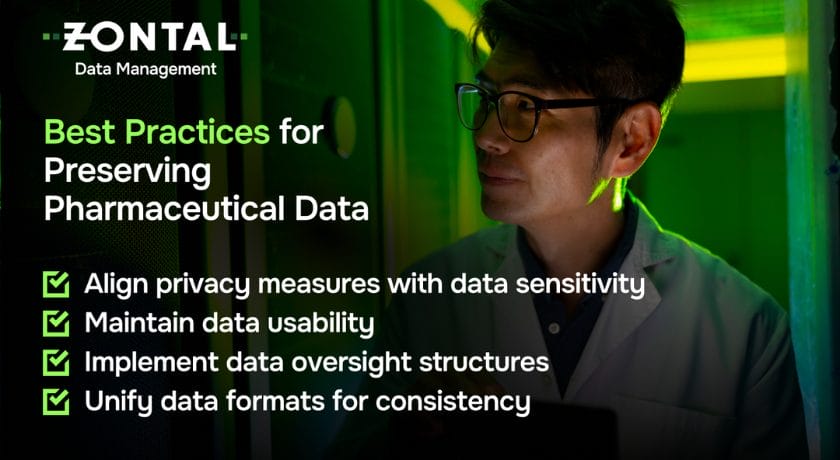Pharmaceutical Data Preservation: Benefits & Best Practices

Pharmaceutical Data Preservation: Key Takeaways
- Long-term data preservation ensures compliance with global standards while also supporting innovation and product safety
- Preserving data means maintaining usability, traceability, and interoperability through metadata enrichment, privacy controls, governance frameworks, and system harmonization
- Effective pharmaceutical data preservation starts with tailored privacy controls and strong data governance
The ICH E6(R2) highlights the industry’s obligation to preserve data in a way that supports traceability and long-term reliability.
But data preservation is more than a compliance box to check; it’s a strategic imperative for maintaining scientific continuity, speeding up regulatory approvals, and protecting patient safety.
In this guide, we will:
- Explore why pharmaceutical data preservation matters
- Discover the regulatory standards that govern it
- Uncover the best practices for preserving pharmaceutical data
- Introduce the best tools and strategies, like ZONTAL, that help future-proof pharmaceutical data across its entire lifecycle
Future-proof your data with ZONTAL.
The Risks of Poor Data Preservation in the Pharmaceutical Industry
Inadequate data preservation exposes pharmaceutical companies to serious risks:
- Data loss: Critical trial, manufacturing, or research data can disappear due to system failures, human error, or outdated formats.
- Product recalls: Poor traceability increases the risk of undetected issues, leading to recalls and reputational damage.
- Delayed approvals: Incomplete data packages slow down or block regulatory review, delaying time to market.
- Redundant research: Without accessible archives, teams may unknowingly duplicate past studies, wasting time and resources.
- Regulatory noncompliance: Missing or inaccessible data can trigger inspection failures, application rejections, or regulatory penalties.
- IP erosion: Lost or unusable data weakens patent claims and limits opportunities for repurposing prior work.
Why Data Preservation Matters in the Pharmaceutical Industry
Effective data preservation empowers pharmaceutical companies to accelerate development, reduce risk, and maximize the long-term value of their data across the product lifecycle.
1. Ensures Regulatory Compliance
Agencies like the FDA and EMA require pharmaceutical organizations to maintain accurate, unaltered records throughout a drug’s lifecycle, from discovery to post-market surveillance.
Preserved data supports audits, regulatory submissions, and inspections by ensuring regulatory data with standards such as GLP and GMP.
A recent analysis underscores the stakes. In September 2021, the FDA ordered several companies to repeat clinical trials after uncovering data integrity violations at two contract research organizations.
2. Supports Long-Term Value and Reusability
Preserved data enables reuse in:
- Longitudinal studies
- Meta-analyses
- Follow-up development
This keeps intellectual property accessible and interpretable well beyond initial experiments.
3. Protects Product and Patient Safety
Data integrity is fundamental for determining drug efficacy, safety, and dosage.
Loss or corruption of experimental data could compromise these assessments, posing risks to patients and leading to costly recalls or legal liabilities.
A 2023 systematic review examined data integrity violations across the pharmaceutical sector.
The study found that issues such as falsification, omissions, and poor recordkeeping directly compromised product quality and patient safety.
4. Improves Operational Efficiency and Innovation
Preserved and well-structured data enables interoperability across platforms (think LIMS and ELNs) streamlining R&D workflows and allowing for automation, AI integration, and efficient knowledge transfer.
ZONTAL’s platform, for instance, centralizes and harmonizes data across systems to support faster decision-making and innovation.
5. Prevents Redundant Work
Preserving data in a FAIR (Findable, Accessible, Interoperable, Reusable) format minimizes redundant experiments, saving time and resources, while accelerating discovery and commercialization.
Investing in long-term data storage solutions ensures data remains available for reuse, even as systems evolve or age.

Global Regulatory Authorities Driving Pharmaceutical Data Preservation
Global regulatory bodies set the rules for how pharmaceutical data must be preserved, protected, and accessed at every stage of the product lifecycle.
These authorities include:
1. U.S. Food and Drug Administration (FDA)
The FDA oversees the development, manufacturing, and marketing of drugs, biologics, and medical devices in the United States.
It enforces standards like 21 CFR Part 11, covering electronic records and signatures, and GLP/GMP guidelines, all of which require data to be accurately preserved, securely stored, and retained for defined periods to maintain integrity and traceability.
2. European Medicines Agency (EMA)
The EMA regulates medicinal products in the EU, enforcing data integrity, GCP, and GMP guidelines that require:
- Long-term retention
- Auditability
- Clinical and manufacturing data accessibility
3. International Council for Harmonization of Technical Requirements for Pharmaceuticals for Human Use (ICH)
The ICH creates harmonized global guidelines to align regulatory standards across regions.
Key documents like ICH E6(R2) on GCP and ICH Q10 on pharmaceutical quality systems emphasize data traceability, integrity, and preservation throughout the lifecycle, ensuring consistent quality and compliance worldwide.
4. Medicines and Healthcare products Regulatory Agency (MHRA)
The MHRA oversees medicines and medical devices in the United Kingdom.
While it aligns with ICH and EMA standards, it also provides its own guidance, especially on data integrity in GxP environments, emphasizing control, accountability, and secure data retention.
Transform compliance into a competitive edge.
Best Practices for Preserving Pharmaceutical Data
Data management is challenging in any industry, but pharmaceutical companies face added pressure from strict privacy laws, regulatory demands, and high-volume, complex workflows.
To meet these demands, organizations need a strategic approach.
Here are the best practices for preserving pharmaceutical data.
1. Tailor Privacy Controls to Data Sensitivity
Not all pharmaceutical data requires the same level of protection.
Patient health records, which contain personally identifiable information (PII), demand strict confidentiality. In contrast, sales data, while commercially sensitive, carries fewer privacy risks.
ZONTAL’s data classification and permission framework allows organizations to calibrate controls based on data sensitivity, enabling anonymization workflows for PII while maintaining flexibility for other data types.
2. Preserve Business Utility Alongside Privacy
Privacy protection shouldn’t compromise the value of sensitive data. Pharmaceutical data must remain useful for follow-up, safety tracking, and development.
Instead of deleting PII from clinical trial records, replacing it with encrypted identifiers linked to a secure database maintains both compliance and long-term usability.
3. Establish Strong Data Governance Frameworks
Effective data preservation starts with clear governance.
Organizations should define how data is classified, accessed, and protected, using tools like encryption, access controls, and audit trails.
Centralizing data platforms and governance teams helps prevent duplication, leakage, and inconsistent handling across business units.
ZONTAL provides a unified governance layer with built-in access controls, digital signatures, and audit trails.
This ensures consistent policy enforcement and 21 CFR Part 11 regulatory data compliance across all data environments.
4. Standardize Data Through Harmonization
Data harmonization brings consistency across systems, which is essential in pharmaceutical supply chains.
Take stability studies, for example.
A single compound stored under multiple conditions is often referenced inconsistently across systems, whether in a LIMS, an ELN, or a CRO report.
Despite being the same material, variations in labeling or metadata can lead to misinterpretation, redundant work, or regulatory delays.
ZONTAL eliminates this disconnect by:
- Converting diverse file formats into a vendor-neutral Allotrope Simple Model (ASM)
- Automatically harmonizing metadata such as sample identifiers, units, and method names
- Creating a unified, searchable data layer that spans internal systems and external collaborators

How ZONTAL Enables Long-Term Data Storage Solutions for Pharma
ZONTAL’s platform enables pharmaceutical companies to move beyond basic data storage and into true long-term preservation, ensuring compliance, usability, and future-readiness.
Here’s how:
- High-throughput, vendor-neutral ingestion: Capture and convert data from a wide array of instruments and sources into standardized, future-proof formats.
- Metadata enrichment and intelligent archiving: Automatically tag datasets with rich metadata, making them searchable, contextualized, and ready for downstream analytics or regulatory inspection.
- 21 CFR Part 11 compliance and audit readiness: Maintain full traceability with built-in electronic signatures, role-based access, and immutable audit trails that meet FDA and EMA regulatory data compliance standards.
- Harmonized, interoperable architecture: Consolidate fragmented ELNs, LIMS, and legacy systems into a unified data layer, eliminating silos and enabling AI/ML integration.
- Future-proofed data strategy: Support FAIR principles while reducing IT overhead, enabling data reuse, and accelerating regulatory submissions.
Unlike conventional systems, ZONTAL is one of the few platforms that combine vendor neutrality with semantic data enrichment, allowing organizations to harmonize data from diverse sources while preserving its full contextual value.
With ZONTAL, data preservation becomes a catalyst for innovation, not a compliance bottleneck.
Preserve your data with ZONTAL.
Pharmaceutical Data Preservation: FAQs
Why is long-term data preservation critical in the pharmaceutical industry?
Pharmaceutical companies must retain data for many years to meet regulatory requirements, support future research, and protect intellectual property.
Poor preservation can lead to compliance issues, data loss, or costly rework.
How does data preservation differ from data storage?
While data storage simply holds information, data preservation ensures it stays usable, searchable, and compliant over time.
This involves adding metadata, standardizing formats, verifying integrity, and maintaining long-term accessibility.
How can pharmaceutical companies protect their data?
To minimize security risks, pharmaceutical organizations need a multi-layered approach to data protection.
This means:
- Regularly auditing systems
- Using role-based access controls
- Encrypting sensitive data
- Training employees on compliance
- Backing up data securely
- Having a clear incident response plan in place
What are the core principles of data integrity in pharma?
Pharmaceutical data must adhere to five key principles: it should be attributable, legible, contemporaneous, original, and accurate.
These standards, often summarized as ALCOA, ensure that data remains trustworthy and verifiable.
Regulatory bodies frequently audit organizations to confirm that these integrity benchmarks are consistently met.
Which regulations govern pharmaceutical data preservation?
Key standards include FDA 21 CFR Part 11, EMA GxP guidelines, ICH E6(R2), MHRA data integrity guidance, and PMDA requirements, all of which emphasize long-term retention, traceability, and audit readiness.
How can ZONTAL support data preservation efforts?
ZONTAL offers a vendor-neutral, regulatory-compliant platform that captures, harmonizes, and archives high-throughput data.
With built-in metadata enrichment, secure storage, and FAIR principles, it ensures your data stays accessible, interoperable, and future-ready.
Still have questions about data preservation?
 >
> 

